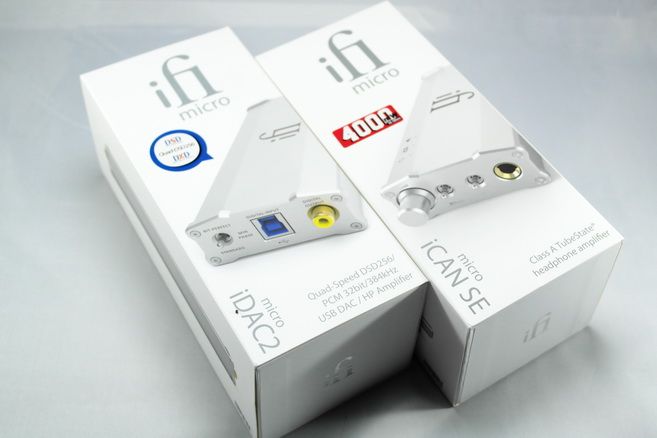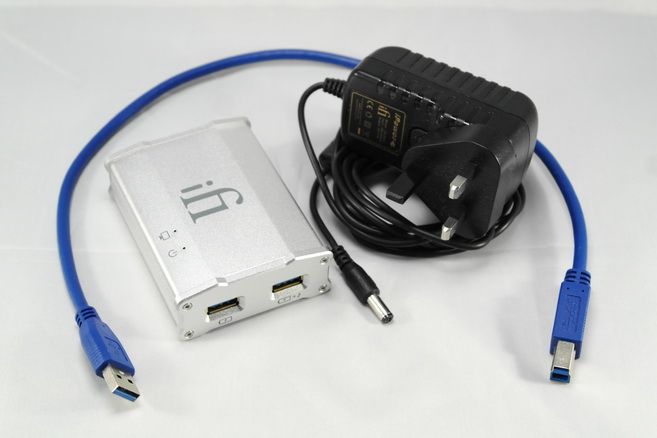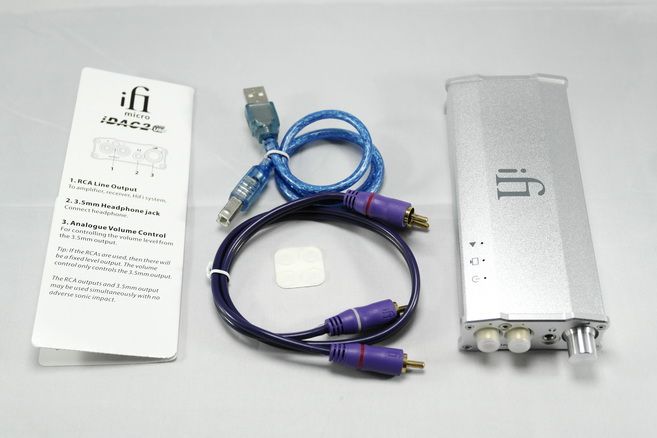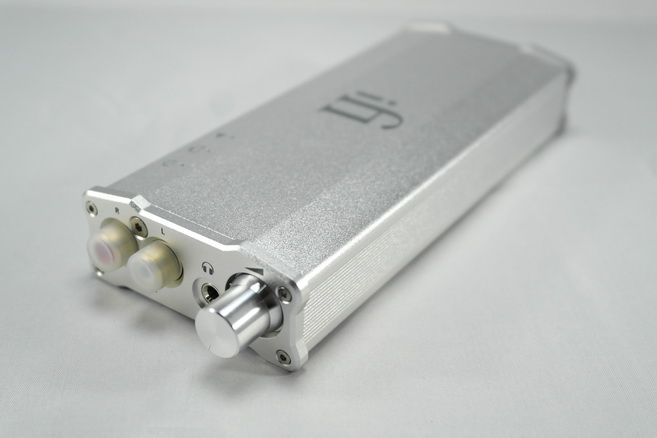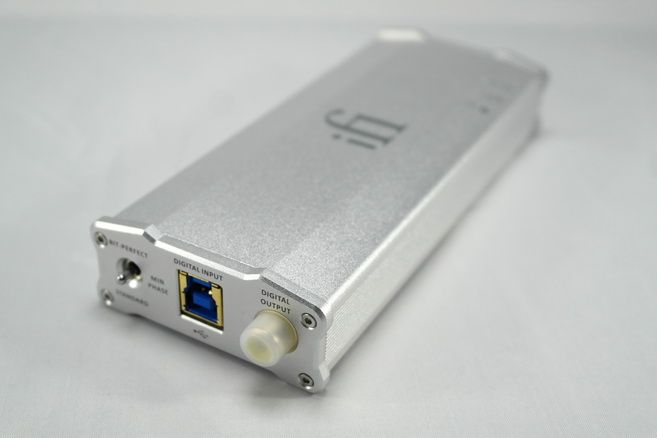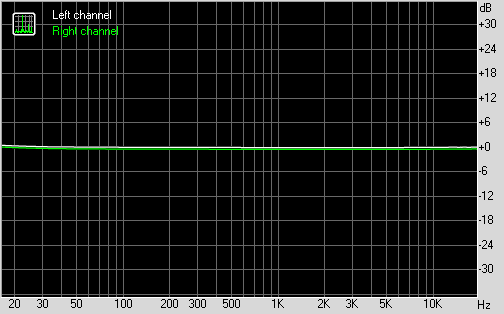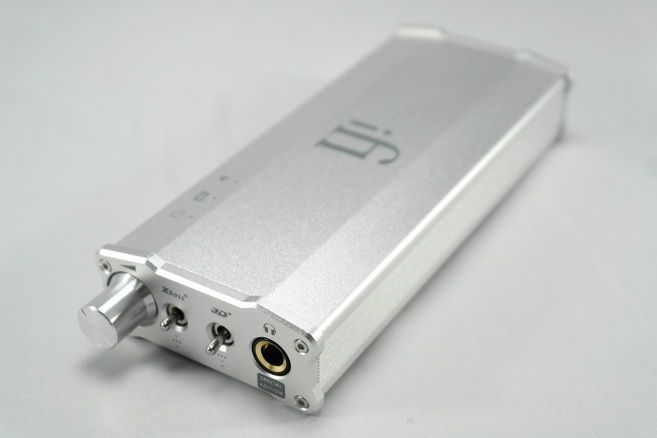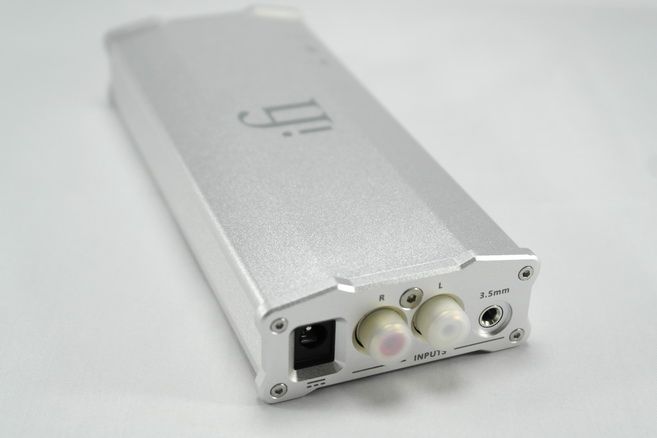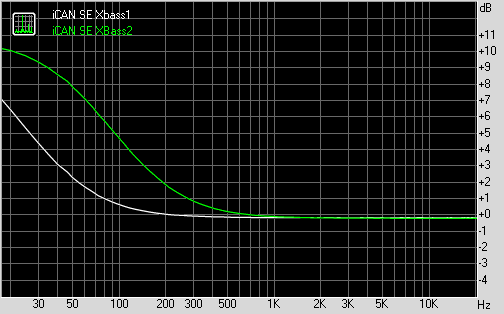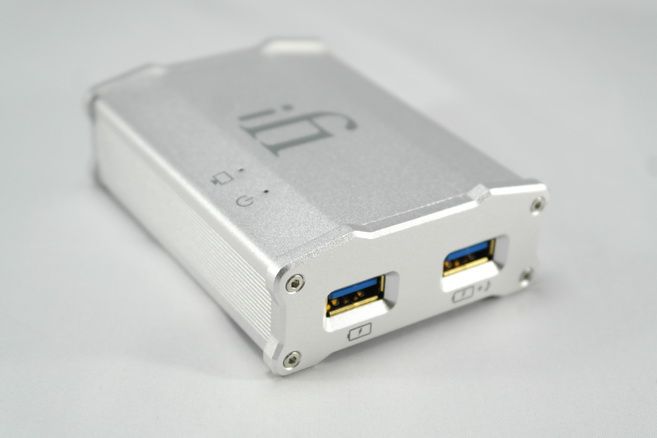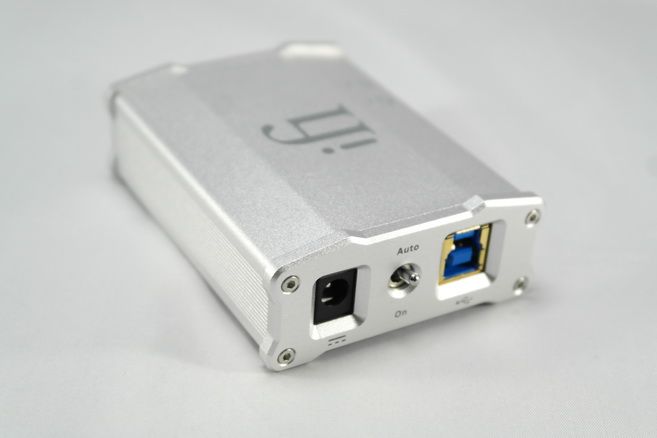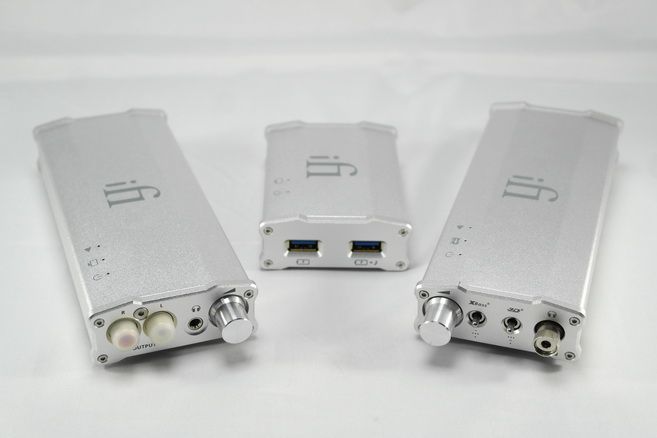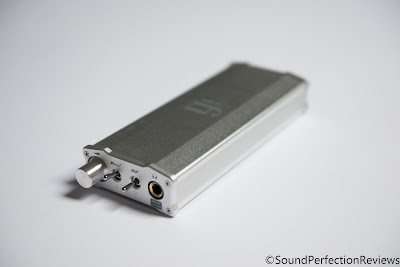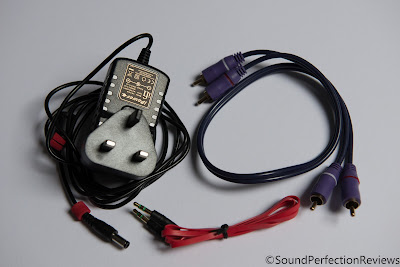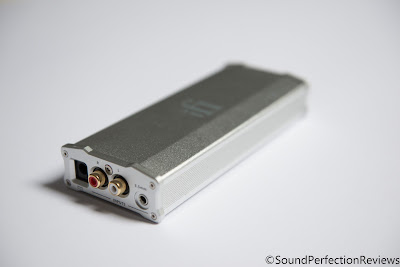I've been hearing people sing praise's about iFi Audio for years. An for good reason, based out of London UK iFi Audio's has been know for it's excellent welcoming sound signature. I was fortunate enough to be able to get a hold of a demo unit directly though iFi Audio, my thoughts of it are my own and I have not been compensated for them.
The iCan SE retails for $299 presently via Amazon, it's also stocked in a wide variety of brick and mortar locations as well. Be sure to support your local audio shops if your fortunate enough to have one! Here in Myrtle Beach, the nearest shop is three hours from me, so I'm stuck ordering most everything online.
How is it built and packaged?
The including packing is subtle, clean, well thought out and colorful. The design is certainly retail shelf friendly, the colors pop and really draw your eye. The construction of the packing isn't too elaborate either, it's efficient, light weight and attractive.


The outer sleeve holds the inner box together, cradle inside is the amp on top with a spot for cables beneath it.


The included inter-connectors and power cable are tucked away neatly beneath the amp it self. Divided by a semi-hard foam insert in which the amp itself is nestled into.

The included cables are very colorful, light weight with a nice bit resistance when plugging them in.
What I found most unique about the operation of the iFi Micro iCan was that it lacked a power button! The Amp simply plugs in and runs, it's operational temperature stays cool despite being powered almost 24/7. Combine that with it's exceptionally low weight and sleek overall size, an you can confidently store your Micro iCan SE any where that's convenient! It's designed to fit into your space, requiring little to no fuss to get up and running.

Simplicity and efficiency in design carry over from the packing to the build and layout of the amp it self. All Inputs are placed on the rear, with outputs in the front.

Each of the mechanical switches for the xBass and 3D settings are heavy with a satisfying solid action. Again, there is little to no play in any mechanical component of this amp! The volume knob is weighted well an rotates smoothly. I had no issues adjusting the volume as needed.


Each of the inputs and outs have a good smooth resistance and grip on the cables fed into them. Additionally 4 small plastic gain switches are located on the very bottom of the amp. They can be set for 3 different configurations, low, med and high gain.
iFi Audio includes two analogue signal processing options, 3D for enhanced imaging and the xBass bass boost. The bass boost works as intended, when activated there is a marginal amount of noise added. I for the most part used the lower boost for EDM and some Drum n Bass tracks. It worked equally well with both tradtional dynamic and planar magnetic headphones. The 3D analogue signal processing settings worked spectacular with dynamic headphones, consistently creating a more spacious an defined image overall. My planar magnetic saw improvements irregularly, often times there was increased distortion, added noise and undesired changes to the frequency response. Though when it worked, it worked very well.
For the most part the iFi Micro iCan SE had a very black background, especially when fed a hot signal with the volume knob sitting between 9 and 5 o'clock. How ever, when set to either the minimum or maximum rotated position there was some audible interference, quite literally either TV or Radio. For reference, I don't have a TV or Radio receiver in my home but I do have two stations within a couple miles of me.
As per the iFi Audio site, the operational specs for the Micro iCan are as followed;

How does it Sound?
Before moving forward please kindly take a moment to refresh your self on the meaning of terminology I use to describe sound.
Overall I found the sound signature of the iFi Audio Micro iCan Special Edition to be;
For the purpose of this review, I sourced the iFi Audio iCan Micro SE from my Audio GD NFB10ES2 which is it self fed via FooBar 2000 ASIO Out into my Schiit Etir. I've got Pagnea Audio Power Cables for my Dac and I'm using Blue Jean Cable's Coaxial and RCA interconnects. My listening impressions were done at an average of 85 dBs and all comparisons were level matched beforehand.
Pairing the iCan SE is super easy! The ASP functions make minor enough adjustments to give the amp flexibility with a variety of sound signatures. I enjoyed my Nhoord Red V1 the most with the iCan SE.

The Nhoord Red v1 is a DIY Grado style headphone, it's sound is very similar to the Grado RS1i, as such it's my go to can for relaxed fun listening. As such, the two paired together well. Offering a very smooth beautiful organic sound. The Tube State iCan SE helped to alleviate some ringing in the mid range and some harshness up top for the Nhoord Red V1. I found the dynamics remained punchy and both ASP 1 and xBass 1 gave the Nhoord Red V1 a more spacious and balanced sound overall! Each of the ASP settings made a noticeable improvement to the sound of the Nhoord Red V1, and the noise introduced was very minimal if any. The 3D ASP Lvl 1 setting in particular really opened up the sound stage for me, giving me both gains in vertical space as well as front and rear space. The iCan SE was able to tackle and mitigate many of the Nhoord Red V1's weaknesses.
I really love listening to the live rendition of Hotel California from the Hell Freeze's over album. Without the iCan SE, the Nhoord Red V1 compresses the very large sense of space I know the recording originates from, activating the 3D ASP Lvl 1 restores a great sense of front/rear depth. Putting the audience slightly behind and the guitars more so in front, creating a very real sense of 3D space! While retaining a good creamy slightly intimate presentation to the guitars. Using the xBass Lvl 1 also helped pull out a little more of the deeper lows from the big drum present during the intro. The only draw back was the bass guitar as then a little more forward than I personally like.
Mid Range Dynamics headphones like the Nhoord Red V1 are were I feel the iCan SE shines the most! Many of these headphones have similar level's of resolve but differ vastly in sound signature and imaging abilities. The iFi Audio Micro iCan SE ASP settings make it easy to pair your favorite sound signature with more balanced imaging.

With my ZMF Eikon I was impressed by how much more power I had to get it loud though I was less impressed with the quality of sound. For starters the 3D ASP Lvl 1 was required, as with it off the sound stage was too intimate and compressed. Additionally the xBass ASP settings were noticeably nosier with the more resolving Eikon. Ultimately I feel the iCan SE sound signature was a poor match for the Eikon, as the relaxed sound of the amp didn't pair too well with the relaxed tilt of the headphone. Ultimately, while the tonality was wonderful the timbre was off and there was a noticeable lack of dynamics.

Another LOUD but less than ideal combo. If you currently own an inefficient hard to drive planar magnetic like the HE 4 then iFi Audio iCan SE has the power to get loud but doesn't have a the response time necessary to preserve detail at the level I know the HE 4 can operate at, I'll get more in depth on that during my the comparison section. While it's tonally very pleasing, the sound lacked the detail and dynamic range I expect from my HE 4. But out of everything I own the iFi Micro iCan SE had the most head room! It got my HE 4 louder than anything else I own. Additionally, both the xBass and 3D ASP settings resulted most often in undesirable changes. 3D ASP Lvl 1 worked positively for about 1/10 songs. Most of the time it degraded the overall imaging for the HE 4 as opposed to improving it.

The more efficient LCD XC pair'd beautifully with the iCan SE. The smoother warm sound of the iCan SE helped to tame the XC shouty mid range and sharper top end. Additionally the sheer power output of the iCan SE kept the lows very taut and lean.
Listening to Miles Davis's So What I'm used to the XC presenting a very metallic sounding horn, with the iCan SE the mid range mellows out nicely, yielding an overall more natural sound. Again the 3D ASP Lvl 1 opens up the sound stage, adding a very real 3D sense of space. It adds a touch of vertical space to the horns and the double bass, while also adding some rear depth to the double bass. The 3D ASP also adds a bit of energy up top allowing the percussion and high hats to pop a little more, without the harshness I'm used to from the XC. I wasn't a fan of the xBass boost though, it softened an otherwise lean tactile bass.
How does it compare?
For comparisons I have the amp section of my Audio GD NFB10ES2 and my Project Ember II. For every comparison I level matched the output of each amp within .1 dB using a pink noise mono track.

So the big question I had when I heard about the iCan SE's "Tube State" Class A amplification stage was how does it compare to a tube amp? My Ember II is only a Hybrid Tube but even so it does have a big ole tube in it.
The Ember II is my primary amp for the ZMF Eikon, a large part of why is how the 35R output changes the Eikon. With a lower output impedance the sound is very a little disjointed. The iCan SE's less than 1ohm output was no exception, compared to the Ember II, the iCan SE held back the ZMF Eikon's resolve, dynamics, tactility and beautiful timbre. Additionally the 3D ASP circuit created a artificially large but disjointed image and the xBass boost was just noisy.
Moving to the HE 4, I found only 2 songs that benefited from the 3D ASP. In every other instance the Ember II presented a larger more cohesive 3D image. Additionally, the Ember II brings the HE 4 a more natural sense of warmth without losing to much of it's hyper aggressive sound. The Ember II sits in the middle, not as soft and smoother as the iCan SE while not as hard and exaggerated as the NFB10ES2.
Compared to the Ember II the iCan SE had a slower more simplified decay and drier sound with the LCD XC. There was a lack of sweetness and naturalness. Though the macro detail was on par with both units! The Nhoord Red V1 did a little better, with the 3D ASP Lvl 1 I got a larger sound stage and more precise image with the iCan SE, how ever the Ember II resolved more micro detail and better defined the individual timbre of instruments.
Sadly, the Tube State did not capture all of the magic of the real thing. But here's what it does do! It provides a good tube like sense of warmth that's consistent. The problem with tube amps are the tube's them selves. Each of the different tube types and models make small changes to frequency response and imaging, none of them make a night or day difference but fine tune the nuance of the amp they are pair'd with. So even with recommendations, I had to roll around 7-8 different tubes within the same family before I found the combination that was magical for me. So, if you don't have the time to purchase, listen to, compare and document the sound of dozens of tubes. Than a tube amp may not be the best solution for you. I was fortunate to be able to work with vendors that offered me an exchange seeing as I was buying used, but I was still left with pouring upwards of almost 100 hours of combined listening and research before I found the tube that worked best for me.
iFi Audio's Tube State technology as found in the iCan SE does offer a much more convenient way to enjoy the some of the magic found in tube amps without the hassle.
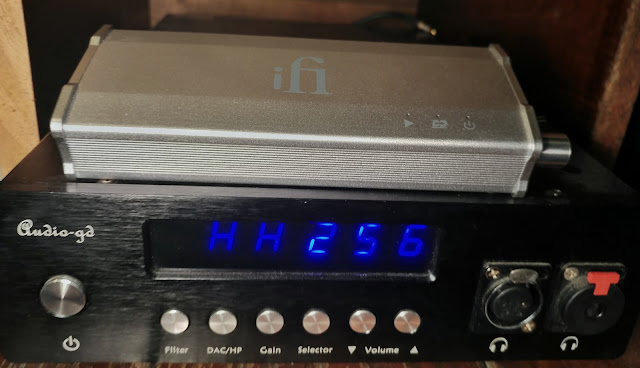
Moving to the NFB 10ES2 the most obvious difference here is size! My NFB10ES2 is huge, so much so it's housed in my own little make shift wood shelf/box. It's a component you make a space for unlike the iFi Micro iCan which fits where ever you'd like it. So forgive the less than optimal picture!
An important note, I have balanced cables for all of my headphones hence I compared the native balanced output of the NFB10ES2 to the Native SE Output of the iCan SE. I also have an OCC Copper 4pin XLR to 6.5mm Adapter, which I've found to be the most transparent cable choice for that inter-connector.
To preface, the SE Output of the NFB10ES2 is HORRIBLE, in every instance the Single End Output of the iCan SE is noticeably improved over the SE output of my NFB10ES2. Again the NFB10ES2 functions best as a balanced head amp.
Now starting with the bad, moving to the NFB10ES2 from the iCan SE with the HE 4 netted a noticeable improvement to almost all aspects of the sound. The harder to drive legacy planar really opened up with the more powerful and quicker output of the NFB10ES2. The smoother more balance tonality of the iCan SE with the HE 4 is not an acceptable compromise, given how soft, unresolved and slow the headphones sounds from it. Though while seldom, there were times were the 3D ASP function did improve the imaging.
Moving to my more efficient LCD XC and Nhoord Red V1, each lacked both micro dynamics and some micro detail when pair'd with the iCan SE. The transition in Hotel California from a single guitar features an immediate eruption of applause from the crowd but the guitars them selves very gradually increase in volume. That complicated transition was simplified with the iCan SE. By the time the crowd settled down the guitars were louder, but you couldn't follow that gradual increase, the sheer noise of the crowd drowned out that change. With the NFB10ES2, the transition was resolved more clearly, you could appreciate the crowd and the gradual transition of the guitars. Additionally, with the NFB10ES2 I noticed when the guitar's reach their peak volume the crowd livens up even more so just before settling down. With 3D ASP level 1 the sound stage of each was very similar, with the iCan SE being marginally noiser.
The NFB10ES2's has a harder presentation, sometimes this worked to it's advantage other times it worked against it. Like wise the iCan SE was softer, which at times was an advantage. There were times too when the softer but blacker presentation of the iCan SE resolved a bit more macro detail than the NFB10ES2 and other times the harder but more dynamic NFB10ES2 resolved more ambient noise. Ultimately I felt these differences were neither good nor bad in reference to fidelity. Just a difference in presentation.
Finally the good! With both headphones, the loss of some tactility was an acceptable compromise for a much more balanced tonality. The LCD XC had a more natural mid range, especially obvious in the vocals and with horns. The Nhoord Red V1 was exceptionally more balanced and enjoyable with the iCan SE. With the 3D and xBass ASP set to level 1 the iCan SE replicated the sound-stage and sheer bass impact that the NFB10ES2 offers. Guitars in particular were creamier with the Nhoord Red V1/iCan SE combo. Ultimately the NFB10ES2 sounds a little harsh and exaggerated when pair'd with both my Nhoord Red V1 and the LCD XC.
These two more efficient headphones pair'd very well with the iCan SE. It's only the harder to drive HE 4 that really benefited from the NFB10ES2 balanced design.

In conclusion the iFi Audio iCan SE brings a warm tube like sound without the hassle of tubes them selves. While it doesn't offer the same level of sound quality as my Ember II pair'd with a 1944 Sylvania 6sn7 GT Tall Bottle White Label, it's also more affordable at only $299 vs $450 respectively. It's flexibility, small footprint and competitive price point are the shining achievements of the iCan SE. The 3D ASP and xBass features allow you to make adjustments to how the amp operates, much the same way rolling different tubes does for a traditional tube amp. The difference is with the iCan SE you can customize the sound of your amp without any additional purchases, without having to power it down, carefully remove a hot fragile glass bottle and try your best not to break anything or burn your hands.
iFi Audio's Micro iCan presents a very relaxing, powerful, stress free, instantly gratifying amp with a warm welcoming sound that you can easily adjust to what ever headphone your listening to. Mid Range Dynamics, headphones like the Grado SR 325, the Beyerdynamic DT 880, Sennhesier HD 600 and Audio Technica AD 900X are were I feel the iCan SE shines the most! Many of these headphones have similar level's of resolve but differ vastly in sound signature and imaging abilities. The iFi Audio Micro iCan SE ASP settings make it easy to pair your favorite sound signature with more balanced imaging, and if you happen to have a small collection they iCan SE can adapt and compliment each of them. That ease of ownership and out of the box flexibility make this a real gem to some one whose aim is to just enjoy their music.
The iCan SE retails for $299 presently via Amazon, it's also stocked in a wide variety of brick and mortar locations as well. Be sure to support your local audio shops if your fortunate enough to have one! Here in Myrtle Beach, the nearest shop is three hours from me, so I'm stuck ordering most everything online.
How is it built and packaged?
The including packing is subtle, clean, well thought out and colorful. The design is certainly retail shelf friendly, the colors pop and really draw your eye. The construction of the packing isn't too elaborate either, it's efficient, light weight and attractive.


The outer sleeve holds the inner box together, cradle inside is the amp on top with a spot for cables beneath it.


The included inter-connectors and power cable are tucked away neatly beneath the amp it self. Divided by a semi-hard foam insert in which the amp itself is nestled into.

The included cables are very colorful, light weight with a nice bit resistance when plugging them in.
What I found most unique about the operation of the iFi Micro iCan was that it lacked a power button! The Amp simply plugs in and runs, it's operational temperature stays cool despite being powered almost 24/7. Combine that with it's exceptionally low weight and sleek overall size, an you can confidently store your Micro iCan SE any where that's convenient! It's designed to fit into your space, requiring little to no fuss to get up and running.

Simplicity and efficiency in design carry over from the packing to the build and layout of the amp it self. All Inputs are placed on the rear, with outputs in the front.

Each of the mechanical switches for the xBass and 3D settings are heavy with a satisfying solid action. Again, there is little to no play in any mechanical component of this amp! The volume knob is weighted well an rotates smoothly. I had no issues adjusting the volume as needed.


Each of the inputs and outs have a good smooth resistance and grip on the cables fed into them. Additionally 4 small plastic gain switches are located on the very bottom of the amp. They can be set for 3 different configurations, low, med and high gain.
iFi Audio includes two analogue signal processing options, 3D for enhanced imaging and the xBass bass boost. The bass boost works as intended, when activated there is a marginal amount of noise added. I for the most part used the lower boost for EDM and some Drum n Bass tracks. It worked equally well with both tradtional dynamic and planar magnetic headphones. The 3D analogue signal processing settings worked spectacular with dynamic headphones, consistently creating a more spacious an defined image overall. My planar magnetic saw improvements irregularly, often times there was increased distortion, added noise and undesired changes to the frequency response. Though when it worked, it worked very well.
For the most part the iFi Micro iCan SE had a very black background, especially when fed a hot signal with the volume knob sitting between 9 and 5 o'clock. How ever, when set to either the minimum or maximum rotated position there was some audible interference, quite literally either TV or Radio. For reference, I don't have a TV or Radio receiver in my home but I do have two stations within a couple miles of me.
As per the iFi Audio site, the operational specs for the Micro iCan are as followed;

How does it Sound?
Before moving forward please kindly take a moment to refresh your self on the meaning of terminology I use to describe sound.
Overall I found the sound signature of the iFi Audio Micro iCan Special Edition to be;
- Warm intimate and relaxed
- Touch of added decay in the lows and mids
- With a smooth top end
- Adaptable
- 3D ASP offers enhanced imaging, a more energetic top end and clearer macro detail when needed
- The default circuit provides black background, slightly warmer sound and excellent micro detail
For the purpose of this review, I sourced the iFi Audio iCan Micro SE from my Audio GD NFB10ES2 which is it self fed via FooBar 2000 ASIO Out into my Schiit Etir. I've got Pagnea Audio Power Cables for my Dac and I'm using Blue Jean Cable's Coaxial and RCA interconnects. My listening impressions were done at an average of 85 dBs and all comparisons were level matched beforehand.
Pairing the iCan SE is super easy! The ASP functions make minor enough adjustments to give the amp flexibility with a variety of sound signatures. I enjoyed my Nhoord Red V1 the most with the iCan SE.

The Nhoord Red v1 is a DIY Grado style headphone, it's sound is very similar to the Grado RS1i, as such it's my go to can for relaxed fun listening. As such, the two paired together well. Offering a very smooth beautiful organic sound. The Tube State iCan SE helped to alleviate some ringing in the mid range and some harshness up top for the Nhoord Red V1. I found the dynamics remained punchy and both ASP 1 and xBass 1 gave the Nhoord Red V1 a more spacious and balanced sound overall! Each of the ASP settings made a noticeable improvement to the sound of the Nhoord Red V1, and the noise introduced was very minimal if any. The 3D ASP Lvl 1 setting in particular really opened up the sound stage for me, giving me both gains in vertical space as well as front and rear space. The iCan SE was able to tackle and mitigate many of the Nhoord Red V1's weaknesses.
I really love listening to the live rendition of Hotel California from the Hell Freeze's over album. Without the iCan SE, the Nhoord Red V1 compresses the very large sense of space I know the recording originates from, activating the 3D ASP Lvl 1 restores a great sense of front/rear depth. Putting the audience slightly behind and the guitars more so in front, creating a very real sense of 3D space! While retaining a good creamy slightly intimate presentation to the guitars. Using the xBass Lvl 1 also helped pull out a little more of the deeper lows from the big drum present during the intro. The only draw back was the bass guitar as then a little more forward than I personally like.
Mid Range Dynamics headphones like the Nhoord Red V1 are were I feel the iCan SE shines the most! Many of these headphones have similar level's of resolve but differ vastly in sound signature and imaging abilities. The iFi Audio Micro iCan SE ASP settings make it easy to pair your favorite sound signature with more balanced imaging.

With my ZMF Eikon I was impressed by how much more power I had to get it loud though I was less impressed with the quality of sound. For starters the 3D ASP Lvl 1 was required, as with it off the sound stage was too intimate and compressed. Additionally the xBass ASP settings were noticeably nosier with the more resolving Eikon. Ultimately I feel the iCan SE sound signature was a poor match for the Eikon, as the relaxed sound of the amp didn't pair too well with the relaxed tilt of the headphone. Ultimately, while the tonality was wonderful the timbre was off and there was a noticeable lack of dynamics.

Another LOUD but less than ideal combo. If you currently own an inefficient hard to drive planar magnetic like the HE 4 then iFi Audio iCan SE has the power to get loud but doesn't have a the response time necessary to preserve detail at the level I know the HE 4 can operate at, I'll get more in depth on that during my the comparison section. While it's tonally very pleasing, the sound lacked the detail and dynamic range I expect from my HE 4. But out of everything I own the iFi Micro iCan SE had the most head room! It got my HE 4 louder than anything else I own. Additionally, both the xBass and 3D ASP settings resulted most often in undesirable changes. 3D ASP Lvl 1 worked positively for about 1/10 songs. Most of the time it degraded the overall imaging for the HE 4 as opposed to improving it.

The more efficient LCD XC pair'd beautifully with the iCan SE. The smoother warm sound of the iCan SE helped to tame the XC shouty mid range and sharper top end. Additionally the sheer power output of the iCan SE kept the lows very taut and lean.
Listening to Miles Davis's So What I'm used to the XC presenting a very metallic sounding horn, with the iCan SE the mid range mellows out nicely, yielding an overall more natural sound. Again the 3D ASP Lvl 1 opens up the sound stage, adding a very real 3D sense of space. It adds a touch of vertical space to the horns and the double bass, while also adding some rear depth to the double bass. The 3D ASP also adds a bit of energy up top allowing the percussion and high hats to pop a little more, without the harshness I'm used to from the XC. I wasn't a fan of the xBass boost though, it softened an otherwise lean tactile bass.
How does it compare?
For comparisons I have the amp section of my Audio GD NFB10ES2 and my Project Ember II. For every comparison I level matched the output of each amp within .1 dB using a pink noise mono track.

So the big question I had when I heard about the iCan SE's "Tube State" Class A amplification stage was how does it compare to a tube amp? My Ember II is only a Hybrid Tube but even so it does have a big ole tube in it.
The Ember II is my primary amp for the ZMF Eikon, a large part of why is how the 35R output changes the Eikon. With a lower output impedance the sound is very a little disjointed. The iCan SE's less than 1ohm output was no exception, compared to the Ember II, the iCan SE held back the ZMF Eikon's resolve, dynamics, tactility and beautiful timbre. Additionally the 3D ASP circuit created a artificially large but disjointed image and the xBass boost was just noisy.
Moving to the HE 4, I found only 2 songs that benefited from the 3D ASP. In every other instance the Ember II presented a larger more cohesive 3D image. Additionally, the Ember II brings the HE 4 a more natural sense of warmth without losing to much of it's hyper aggressive sound. The Ember II sits in the middle, not as soft and smoother as the iCan SE while not as hard and exaggerated as the NFB10ES2.
Compared to the Ember II the iCan SE had a slower more simplified decay and drier sound with the LCD XC. There was a lack of sweetness and naturalness. Though the macro detail was on par with both units! The Nhoord Red V1 did a little better, with the 3D ASP Lvl 1 I got a larger sound stage and more precise image with the iCan SE, how ever the Ember II resolved more micro detail and better defined the individual timbre of instruments.
Sadly, the Tube State did not capture all of the magic of the real thing. But here's what it does do! It provides a good tube like sense of warmth that's consistent. The problem with tube amps are the tube's them selves. Each of the different tube types and models make small changes to frequency response and imaging, none of them make a night or day difference but fine tune the nuance of the amp they are pair'd with. So even with recommendations, I had to roll around 7-8 different tubes within the same family before I found the combination that was magical for me. So, if you don't have the time to purchase, listen to, compare and document the sound of dozens of tubes. Than a tube amp may not be the best solution for you. I was fortunate to be able to work with vendors that offered me an exchange seeing as I was buying used, but I was still left with pouring upwards of almost 100 hours of combined listening and research before I found the tube that worked best for me.
iFi Audio's Tube State technology as found in the iCan SE does offer a much more convenient way to enjoy the some of the magic found in tube amps without the hassle.

Moving to the NFB 10ES2 the most obvious difference here is size! My NFB10ES2 is huge, so much so it's housed in my own little make shift wood shelf/box. It's a component you make a space for unlike the iFi Micro iCan which fits where ever you'd like it. So forgive the less than optimal picture!
An important note, I have balanced cables for all of my headphones hence I compared the native balanced output of the NFB10ES2 to the Native SE Output of the iCan SE. I also have an OCC Copper 4pin XLR to 6.5mm Adapter, which I've found to be the most transparent cable choice for that inter-connector.
To preface, the SE Output of the NFB10ES2 is HORRIBLE, in every instance the Single End Output of the iCan SE is noticeably improved over the SE output of my NFB10ES2. Again the NFB10ES2 functions best as a balanced head amp.
Now starting with the bad, moving to the NFB10ES2 from the iCan SE with the HE 4 netted a noticeable improvement to almost all aspects of the sound. The harder to drive legacy planar really opened up with the more powerful and quicker output of the NFB10ES2. The smoother more balance tonality of the iCan SE with the HE 4 is not an acceptable compromise, given how soft, unresolved and slow the headphones sounds from it. Though while seldom, there were times were the 3D ASP function did improve the imaging.
Moving to my more efficient LCD XC and Nhoord Red V1, each lacked both micro dynamics and some micro detail when pair'd with the iCan SE. The transition in Hotel California from a single guitar features an immediate eruption of applause from the crowd but the guitars them selves very gradually increase in volume. That complicated transition was simplified with the iCan SE. By the time the crowd settled down the guitars were louder, but you couldn't follow that gradual increase, the sheer noise of the crowd drowned out that change. With the NFB10ES2, the transition was resolved more clearly, you could appreciate the crowd and the gradual transition of the guitars. Additionally, with the NFB10ES2 I noticed when the guitar's reach their peak volume the crowd livens up even more so just before settling down. With 3D ASP level 1 the sound stage of each was very similar, with the iCan SE being marginally noiser.
The NFB10ES2's has a harder presentation, sometimes this worked to it's advantage other times it worked against it. Like wise the iCan SE was softer, which at times was an advantage. There were times too when the softer but blacker presentation of the iCan SE resolved a bit more macro detail than the NFB10ES2 and other times the harder but more dynamic NFB10ES2 resolved more ambient noise. Ultimately I felt these differences were neither good nor bad in reference to fidelity. Just a difference in presentation.
Finally the good! With both headphones, the loss of some tactility was an acceptable compromise for a much more balanced tonality. The LCD XC had a more natural mid range, especially obvious in the vocals and with horns. The Nhoord Red V1 was exceptionally more balanced and enjoyable with the iCan SE. With the 3D and xBass ASP set to level 1 the iCan SE replicated the sound-stage and sheer bass impact that the NFB10ES2 offers. Guitars in particular were creamier with the Nhoord Red V1/iCan SE combo. Ultimately the NFB10ES2 sounds a little harsh and exaggerated when pair'd with both my Nhoord Red V1 and the LCD XC.
These two more efficient headphones pair'd very well with the iCan SE. It's only the harder to drive HE 4 that really benefited from the NFB10ES2 balanced design.

In conclusion the iFi Audio iCan SE brings a warm tube like sound without the hassle of tubes them selves. While it doesn't offer the same level of sound quality as my Ember II pair'd with a 1944 Sylvania 6sn7 GT Tall Bottle White Label, it's also more affordable at only $299 vs $450 respectively. It's flexibility, small footprint and competitive price point are the shining achievements of the iCan SE. The 3D ASP and xBass features allow you to make adjustments to how the amp operates, much the same way rolling different tubes does for a traditional tube amp. The difference is with the iCan SE you can customize the sound of your amp without any additional purchases, without having to power it down, carefully remove a hot fragile glass bottle and try your best not to break anything or burn your hands.
iFi Audio's Micro iCan presents a very relaxing, powerful, stress free, instantly gratifying amp with a warm welcoming sound that you can easily adjust to what ever headphone your listening to. Mid Range Dynamics, headphones like the Grado SR 325, the Beyerdynamic DT 880, Sennhesier HD 600 and Audio Technica AD 900X are were I feel the iCan SE shines the most! Many of these headphones have similar level's of resolve but differ vastly in sound signature and imaging abilities. The iFi Audio Micro iCan SE ASP settings make it easy to pair your favorite sound signature with more balanced imaging, and if you happen to have a small collection they iCan SE can adapt and compliment each of them. That ease of ownership and out of the box flexibility make this a real gem to some one whose aim is to just enjoy their music.









.png)

![color]](https://audioprimate.files.wordpress.com/2017/02/ican-se-rating-scale.png[color=rgb(61, 89, 109)][/color])






 The past few months have been incredible with it, and I will be purchasing a unit for myself with my own funds as I already know that I am going to miss having it in my audio rack. I am receiving no discounts for my opinion on this, or any other equipment. I like what I like, and don't what I don't....
The past few months have been incredible with it, and I will be purchasing a unit for myself with my own funds as I already know that I am going to miss having it in my audio rack. I am receiving no discounts for my opinion on this, or any other equipment. I like what I like, and don't what I don't.... 








